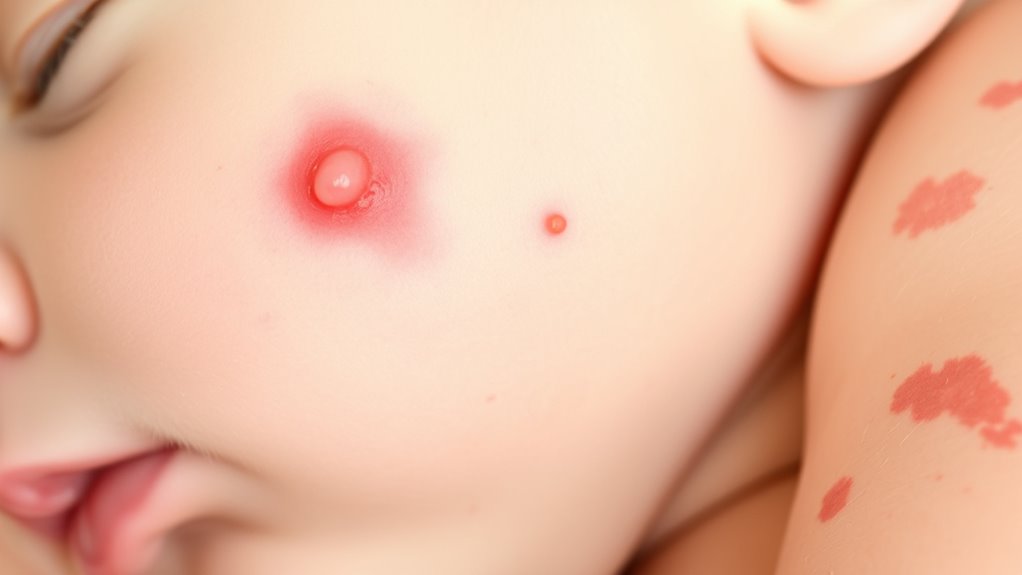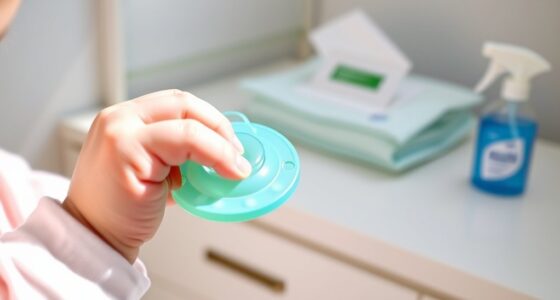Babies often get skin conditions like diaper rash, heat rash, milia, cradle cap, baby acne, or eczema. Most are harmless and improve with gentle care, keeping skin clean, dry, and breathable. Use appropriate fabrics and avoid overdressing. Recognize early signs of discomfort or worsening, and apply soothing treatments as needed. If you’re curious about how to manage each issue or when to seek help, there’s more to discover that can help you care for your little one.
Key Takeaways
- Recognize common rashes like diaper rash, heat rash, milia, cradle cap, and baby acne, which are usually harmless and self-resolving.
- Use gentle cleansing, breathable fabrics, and proper ventilation to prevent and manage skin irritations.
- Apply barrier creams for diaper rash and moisturize eczema with fragrance-free products to reduce flare-ups.
- Dress babies in lightweight, breathable clothing and keep environments cool to prevent overheating and heat rash.
- Seek medical help if rashes worsen, spread, cause discomfort, or show signs of infection or breathing difficulty.
Diaper Rash: Causes and Remedies

Diaper rash is a common skin irritation that occurs when your baby’s delicate skin comes into prolonged contact with moisture, friction, or irritants in the diaper area. To prevent diaper rash, you should change diapers frequently, gently clean the area with water and mild soap, and allow the skin to air out whenever possible. Using barrier creams or ointments with zinc oxide can protect your baby’s skin from moisture and irritants. If a rash appears, diaper rash remedies like applying a thick layer of diaper rash cream, keeping the area dry, and avoiding tight diapers can help soothe your baby’s skin and promote healing. Remember, prompt attention and proper hygiene are key to preventing and managing diaper rash effectively. Regularly checking for signs of irritation and ensuring proper airflow in the diaper area can further reduce the risk of rash development.
Milia: Tiny White Bumps on Baby’s Face
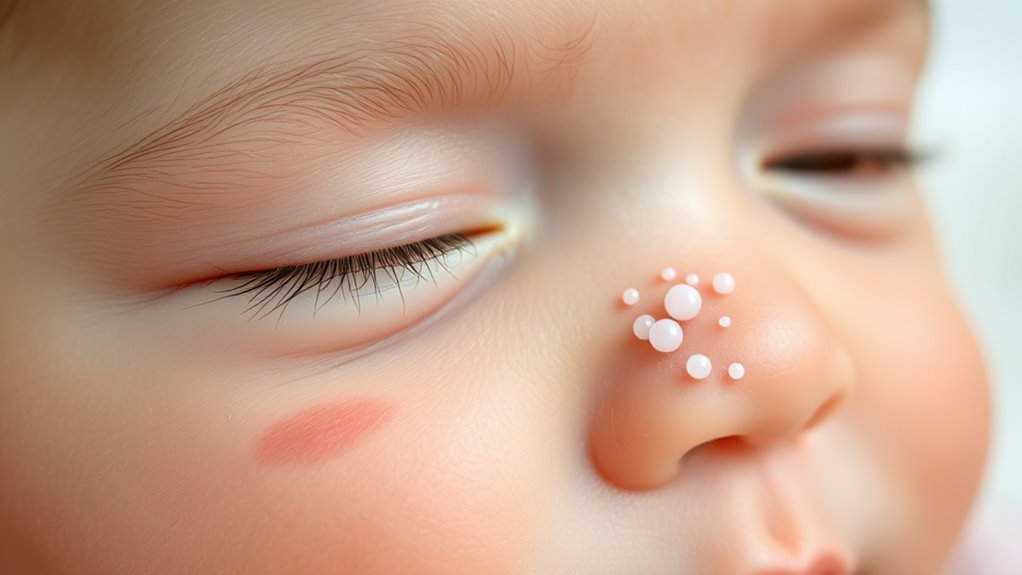
Milia are small, white bumps that often appear on your baby’s face, especially around the nose, cheeks, and forehead. They’re common and usually harmless, often resolving on their own within a few weeks. When establishing baby skincare routines, gentle cleansing and avoiding harsh products help keep skin healthy. It’s important to know milia versus other bumps, like baby acne or rashes, which may look similar but require different care. Milia don’t cause discomfort or itchiness, so you don’t need to squeeze or scrub them. Simply keep your baby’s face clean and moisturized. If you’re unsure whether bumps are milia or something else, consult your pediatrician for guidance. Proper identification guarantees you provide the right care and avoid unnecessary worry.
Cradle Cap: Managing Crusty Scalp Conditions
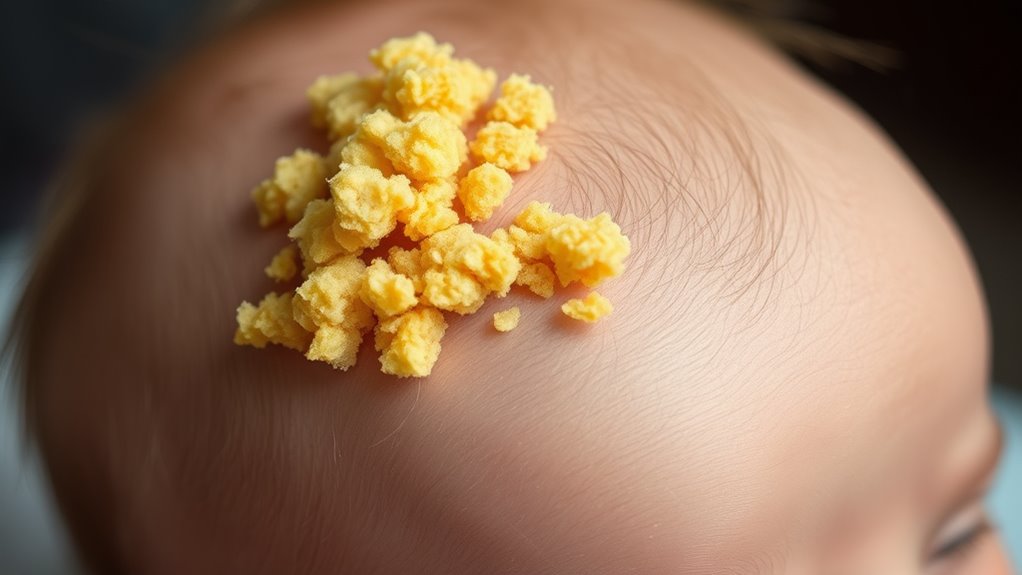
Cradle cap, also known as seborrheic dermatitis, is a common scalp condition that causes crusty, flaky patches on your baby’s head. You might notice scalp peeling or thick, yellowish scales. To manage it, gently massage your baby’s scalp with natural remedies like mineral oil or coconut oil to loosen the crusts. After applying oil, wait a few minutes, then use a soft brush or fine comb to loosen the flakes carefully. Washing the scalp with a gentle baby shampoo helps remove loosened scales. Avoid harsh products or excessive scrubbing, which can irritate the skin. Keep the scalp moisturized and observe for improvements. Regular gentle cleaning and proper scalp care can help prevent recurrence and promote healing. Additionally, understanding the underlying causes, such as excess oil production or dermatitis, can aid in better managing the condition. Most cases improve with simple care, but consult your pediatrician if the condition persists or worsens.
Eczema in Infants: Recognizing and Treating Dry, Itchy Skin

You might notice your baby’s skin becoming red, dry, and itchy, which are common signs of eczema. Recognizing these symptoms early helps you manage the condition effectively. Learning about treatment options guarantees your little one stays comfortable and skin stays healthier. Additionally, understanding the importance of fostering a digital-friendly environment at home can support overall skin health by reducing screen time-related irritations and promoting healthier habits. Creating a balanced routine that limits screen time can help prevent skin irritations caused by prolonged exposure to digital devices. Incorporating gentle, natural essential oils for skin care, such as lavender or tea tree oil, may also aid in soothing irritated skin when used appropriately. Paying attention to environmental factors, like humidity and allergens, can further help in managing eczema symptoms. As advancements in AI-driven security systems continue, they can also help protect your family’s digital environments and personal information.
Identifying Eczema Symptoms
Eczema in infants often presents as dry, itchy patches of skin that can be easily mistaken for other rashes. You might notice areas that look red, inflamed, and rough to the touch. The skin may appear flaky or scaly, especially on the cheeks, forehead, or behind the ears. Skin irritation from eczema can cause your baby to scratch, making the rash worse or leading to open sores. Watch for persistent dry skin that doesn’t improve with regular moisturizing. The affected areas are often itchy, causing discomfort and fussiness. Recognizing these symptoms early helps you distinguish eczema from other skin conditions. If you see these signs, it’s important to consult your pediatrician for proper diagnosis and guidance. Developing a creative practice of observing your baby’s skin carefully can help you identify subtle changes early on. Understanding the skin conditions common in infants can guide you in seeking appropriate treatment and care. Paying attention to emotional responses such as fussiness or irritability may also provide clues about your baby’s discomfort and the importance of energetic alignment in soothing their distress. Additionally, awareness of flaky or scaly skin can help differentiate eczema from other rashes that may have different causes or treatments.
Effective Treatment Strategies
Effective treatment begins with consistent moisturizing to restore the skin’s barrier and reduce dryness. Use gentle, fragrance-free moisturizers to lock in hydration and support skin barrier repair. Alongside regular moisturizing, consider natural remedies like aloe vera or coconut oil, which can soothe irritated skin and reduce inflammation. Avoid harsh soaps and detergents that can worsen dryness and itchiness. Keep your baby’s skin protected from irritants and allergens that may trigger flare-ups. If your baby’s eczema persists or worsens, consult your pediatrician for tailored treatment options. Remember, maintaining a regular skincare routine with gentle, natural products can considerably improve your baby’s comfort and skin health. Focus on skin barrier repair for long-term relief and healthier skin. Additionally, implementing gentle skincare products can help prevent further irritation and promote healing.
Heat Rash: Signs and Prevention During Warm Weather
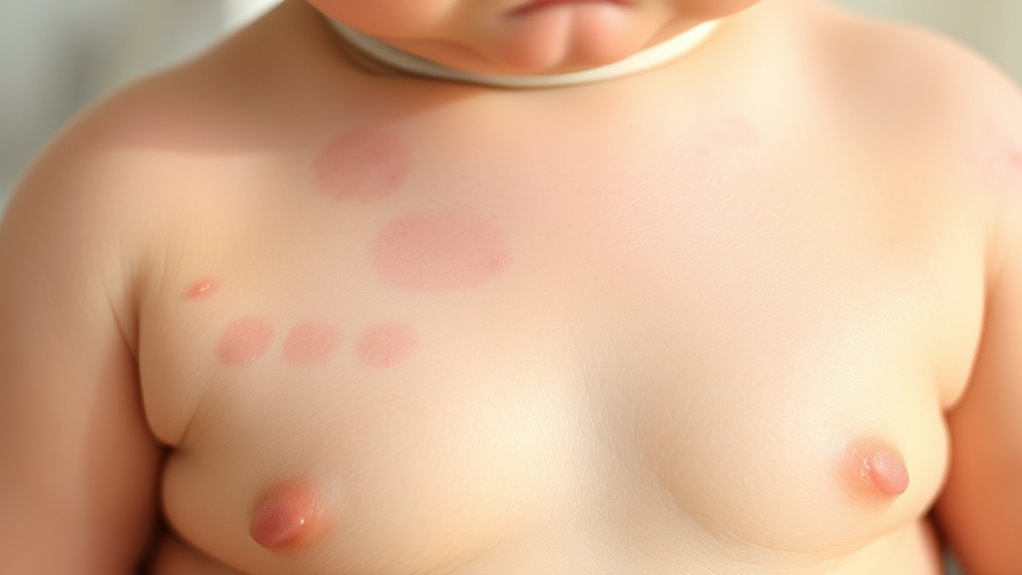
When the weather heats up, your baby might develop heat rash, which shows as small, red bumps or blisters. To prevent it, choose lightweight, breathable clothing and keep your baby cool with strategic cooling methods. Recognizing the signs early helps you take quick action to keep your little one comfortable.
Recognizing Heat Rash Signs
Heat rash, also known as prickly heat, often shows up quickly when your baby is exposed to hot, humid weather. It occurs when sweat gland blockage traps sweat beneath the skin, leading to skin irritation. You might notice small, red bumps or clusters of blisters that feel itchy or prickly. The rash commonly appears on areas where sweat accumulates, such as the neck, armpits, or diaper area. Your baby may seem uncomfortable, fuss, or have difficulty sleeping. Recognizing these signs early allows you to take steps to cool your baby down and reduce skin irritation. Keep an eye out for sudden redness, bumps, or a prickly sensation on their skin, especially during warm weather. Prompt identification helps prevent the rash from worsening.
Preventive Clothing Tips
To help prevent heat rash in your baby, choosing the right clothing is crucial. Focus on clothing fabric choices that are lightweight, breathable, and moisture-wicking, such as cotton or linen. Avoid synthetic fabrics that trap heat and sweat, increasing the risk of rash. Seasonal wardrobe planning plays an important role—dress your baby in lighter layers during hot weather and ensure clothes fit loosely to promote air circulation. Regularly check for signs of overheating and change damp or tight clothing promptly. Keep an extra set of breathable clothes on hand for quick changes. By selecting appropriate fabrics and adjusting your baby’s wardrobe according to the season, you reduce the likelihood of heat rash and keep your little one comfortable and cool during warm weather. Additionally, understanding how projector contrast ratios impact image clarity can help you create a comfortable visual environment if you’re setting up a space for your family. Incorporating appropriate clothing choices that align with SQA principles, such as selecting materials that promote optimal performance, can also be beneficial in other areas of quality management. To further enhance comfort, consider using natural fibers that allow the skin to breathe and minimize irritation.
Effective Cooling Strategies
During warm weather, implementing effective cooling strategies is essential to prevent heat rash in your baby. You can use simple cooling techniques like keeping the room well-ventilated, using fans, or air conditioning to help with temperature regulation. Dress your baby in lightweight, breathable clothing that allows air circulation and absorbs sweat. Offer frequent, small feedings and encourage your baby to take breaks from direct sunlight. Keeping skin dry is vital, so gently pat your baby’s skin after baths or sweating episodes. Avoid overdressing or bundling up your baby too tightly. Be mindful of skin irritation prevention to ensure your baby remains comfortable and safe. Using appropriate ventilation can help reduce indoor heat and humidity, lowering the risk of heat rash. Proper temperature regulation keeps your baby safe and comfortable during warm weather. Additionally, maintaining a cool environment can also help in preventing heat exhaustion, which is an important aspect of heat safety for your little one. Ensuring adequate hydration is also critical for overall heat safety and keeping your baby comfortable.
Baby Acne: What It Is and When to Seek Help

Baby acne is a common skin condition that usually appears as small red or white bumps on your baby’s face, often developing within the first few weeks of life. Genetics influence baby acne, meaning if family members had similar skin issues, your baby might be more prone to it. Hormonal changes trigger baby acne by stimulating oil glands, leading to these bumps. The condition isn’t caused by poor hygiene or allergies, so you don’t need to scrub or scrub your baby’s skin aggressively. Usually, baby acne resolves on its own within a few months without treatment. However, if the bumps become infected, look very inflamed, or if you’re concerned about your baby’s skin, it’s best to seek help from your pediatrician for proper advice and care.
Allergic Reactions and Contact Dermatitis in Babies
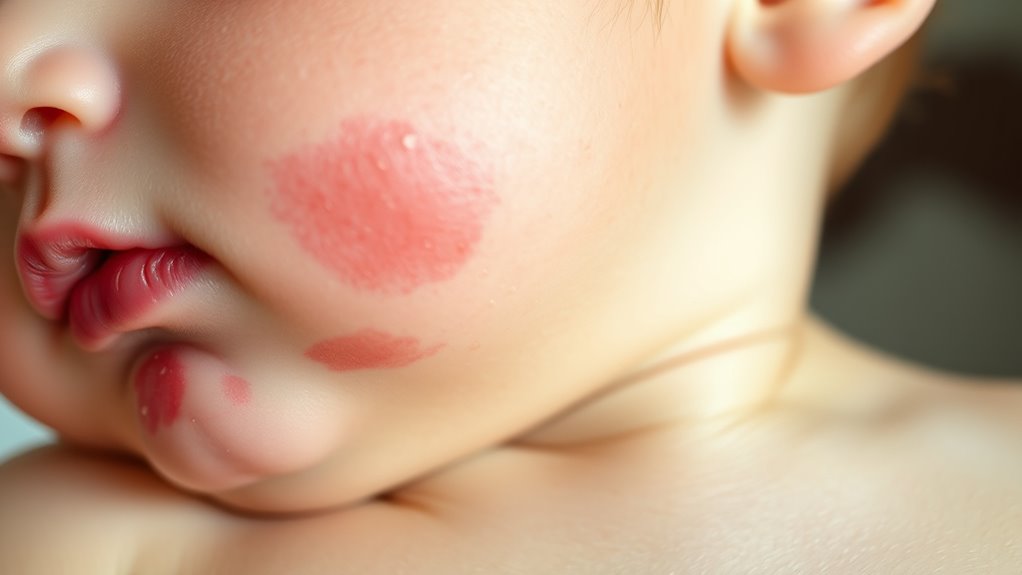
Allergic reactions and contact dermatitis are common skin issues in babies that often result from exposure to irritants or allergens. You might notice redness, swelling, or rash after your baby touches certain products, fabrics, or substances. Allergic reactions can cause hives or more widespread swelling, while contact dermatitis usually presents as dry, itchy, inflamed skin. To manage these conditions, identify and avoid known triggers like soaps, detergents, or certain fabrics. Keep your baby’s skin clean and moisturized, and consider using hypoallergenic products. If the rash worsens, spreads, or is accompanied by difficulty breathing or swelling, seek medical attention immediately. Proper care and prompt response can help reduce discomfort and prevent complications from allergic reactions and contact dermatitis.
Frequently Asked Questions
How Can I Differentiate Between Various Types of Baby Rashes?
To differentiate between various rash types, pay attention to their appearance, location, and accompanying symptoms. You can identify skin condition signs by noting if the rash is red, raised, blistered, or raw. Observe where it appears—on the face, diaper area, or body—and note if your baby shows discomfort or other signs of illness. This helps you understand rash types better and decide when to seek medical advice for proper skin condition identification.
Are There Natural Remedies for Common Baby Skin Conditions?
Did you know that over 80% of parents prefer natural remedies for their baby’s skin? You can try herbal remedies like chamomile or calendula for soothing rashes, and always opt for gentle skincare products. These natural options can help reduce irritation and support your baby’s delicate skin, but remember to consult your pediatrician first to guarantee safety and effectiveness. Natural remedies often promote healing without harsh chemicals.
When Should I See a Doctor for a Baby Rash?
You should see a doctor for a baby rash if it worsens despite diaper rash prevention efforts, or if you notice signs of an allergic reaction like swelling, difficulty breathing, or hives. Also, seek medical advice if the rash spreads, becomes very red or blistered, or if your baby has a fever. Prompt care guarantees your little one stays comfortable and avoids complications.
Can Certain Foods Cause Skin Reactions in Infants?
You’re hitting the nail on the head—certain foods can definitely cause skin reactions in infants. Food allergies often act as dietary triggers, leading to rashes, hives, or irritation. Keep an eye out for symptoms after introducing new foods, and consult your pediatrician if you notice persistent or severe reactions. Early detection helps manage allergies effectively, ensuring your little one stays comfortable and healthy.
How Can I Prevent Rashes From Developing in My Baby?
To prevent rashes in your baby, focus on maintaining good diaper hygiene by changing diapers frequently and gently cleaning the area. Choose soft, breathable clothing that doesn’t irritate your baby’s skin. Avoid tight or rough fabrics, and opt for natural fibers like cotton. Keep the skin dry and moisturized, and watch for signs of irritation. These simple steps help reduce the risk of rashes developing and keep your baby comfortable.
Conclusion
Caring for your baby’s delicate skin is like tending a blooming garden—you’ll notice every tiny change and nurture it back to health. With a gentle touch and keen eyes, you can spot and soothe common rashes and conditions before they bloom into bigger worries. Remember, each bump and redness is just a chapter in your little one’s skin story. Trust your instincts, stay vigilant, and watch your baby’s skin blossom into a healthy, happy glow.

